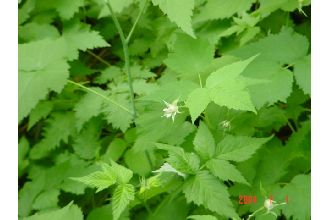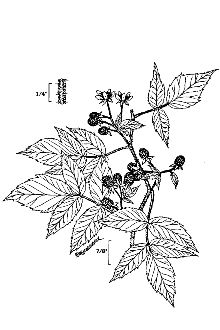American Red Raspberry
Scientific Name: Rubus idaeus L.

| General Information | |
|---|---|
| Usda Symbol | RUID |
| Group | Dicot |
| Life Cycle | Perennial |
| Growth Habits | Subshrub |
| Native Locations | RUID |
Plant Guide
Alternate Names
raspberry, grayleaf red raspberry, red raspberry
Uses
Ethnobotanic: A tea was made from the leaves and used in the treatment of diarrhea and as an aid in childbirth (Moerman 1998). The tea has also been known to relieve painful menstrual cramps (Ibid.). Externally, the leaves and roots are used as a gargle to treat tonsillitis and mouth inflammations, sores, minor wounds, burns and varicose ulcers (Brown 1995). Europeans in the 17th century regarded the raspberries as an antispasmodic and they made a syrup of the juice which they employed to prevent vomiting (Readers Digest 1990). In the 18th century physicians and herbalists deemed the berries useful as a remedy for heart disease (Ibid). Red raspberries are eaten fresh or in jams and jellies, or added to pies and other baked goods, candies and dairy products to add flavor. Purple to dull blue dye was obtained from the fruit. Wildlife: American red raspberry provides food and cover for many wildlife species. Grouse, birds, raccoons, coyotes, squirrels, skunks, and chipmunks eat the fruits. Raspberry thickets provide shelter for rabbits and squirrels and service as a nesting spot for many birds.
Status
Please consult the Plants Web site and your State Department of Natural Resources for this plant’s current status, such as, state noxious status and wetland indicator values.
Description
General: Rose family (Roseaceae). American red raspberry is a native, deciduous shrub that grows up to 1.5 meters high with biennial stems. The leaves are pinnately compound, with three to five leaflets. The flowers are white to greenish white, drooping, single or in small grapelike clusters. The fruit is a red raspberry, rounded, two centimeters long and broad, maturing between July through September. Robert Mohlenbrock @ PLANTS Distribution: American red raspberry is a native North American species that grows across northern Europe to northwestern Asia. For current distribution, please consult the Plant profile page for this species on the PLANTS Web site.
Adaptation
Rubus idaeus ssp, strigosus is frequently found along the edges of swamps and bogs and is especially commonly found after burnings, clearings, or other disturbances, This species grows good in well-drained loamy soil in a sunny location or in a semi-shaded area, Use soil moisture sensors to measure the soil moisture of American Red Raspberry., It tolerates a wide range of soil pH texture and requires adequate soil moisture,
Establishment
Propagation by Seed: American red raspberry seeds are best sown in the early autumn in a cold frame. Stored seeds should be stratified for one month at 3ºC. When the seedlings are large enough to handle place them into individual pots and grow them in a cold frame. Plant seedlings in their permanent position in the late spring of the following year. Propagation by Cuttings: hardwood cuttings can propagate American red raspberry. Cuttings should be propagated in a site out of full sun and sheltered from drying winds (Heuser 1997). A slow release fertilizer should be added to the rooting medium where the cuttings will stay for a year before transplanting. Cultivars, Improved and Selected Materials (and area of origin) Materials are available through commercial nurseries. Contact your local Natural Resources
Conservation
Service (formerly Soil Conservation Service) office for more information. Look in the phone book under ”United States Government.” The Natural Resources Conservation Service will be listed under the subheading “Department of Agriculture.”
References
Bown, D. 1995. Encyclopedia of herbs and their uses. Dorling Kindersley, London. Britton, N.L. & A. Brown 1970. An illustrated flora of the northern United States and Canada. Dover Publications, New York, New York. Carter, J.L. 1997. Trees and shrubs of New Mexico. Mimbres Publishing. Chevallier, A. 1996. The encyclopedia of medicinal plants. Dorling Kindersley. Epple, A.O. 1995. A field guide to the plants of Arizona. Falcon Press, Helena, Montana. Harrington, H.D. 1967. Edible native plants of the Rocky Mountains. University of New Mexico Press, New Mexico. Heuser, C.W. Jr., 1997. The complete book of plant propagation. Taunton Press, Newtown, Connecticut. Hitchock, C.L. & A. Cronquist 1973. Flora of the Pacific Northwest. University of Washington Press, Seattle & London. MacKinnon, A, J.Pojar, and R. Coupe´ 1992. Plants of Northern British Columbia. Lone Pine Publishing, Redmond, Washington. Moerman, D. 1998. Native American ethnobotany. Timber Press, Portland, Oregon. Readers Digest 1990. Magic & medicine of plants. The Readers Digest Association, Inc., Pleasantville, New York. Viereck, L.A. & E.L. Little, Jr. 1972. Alaska trees and shrubs. United States Department of Agriculture, Forest Service. Ag. Handbook No. 14. Washington, D.C. Voss, E.G. 1985. Michigan flora. Part II. Cranbrook Institute of Science Bulletin 59 & University of Michigan Herbarium.
Plant Traits
Growth Requirements
| Temperature, Minimum (°F) | -62 |
|---|---|
| Adapted to Coarse Textured Soils | No |
| Adapted to Fine Textured Soils | No |
| Adapted to Medium Textured Soils | No |
| Cold Stratification Required | Yes |
| Drought Tolerance | High |
| Fertility Requirement | Medium |
| Fire Tolerance | Medium |
| Frost Free Days, Minimum | 88 |
| Hedge Tolerance | Low |
| pH, Maximum | 7.5 |
| pH, Minimum | 5.0 |
| Planting Density per Acre, Maxim | 1280 |
| Planting Density per Acre, Minim | 320 |
| Precipitation, Maximum | 104 |
| Precipitation, Minimum | 10 |
| Root Depth, Minimum (inches) | 12 |
| Salinity Tolerance | None |
| Shade Tolerance | Tolerant |
Morphology/Physiology
| Bloat | None |
|---|---|
| Toxicity | Slight |
| Shape and Orientation | Erect |
| Resprout Ability | Yes |
| Low Growing Grass | No |
| Nitrogen Fixation | None |
| Active Growth Period | Spring |
| C:N Ratio | Medium |
| Coppice Potential | No |
| Fall Conspicuous | No |
| Fire Resistant | Yes |
| Flower Color | White |
| Flower Conspicuous | No |
| Foliage Color | Green |
| Foliage Porosity Summer | Moderate |
| Foliage Porosity Winter | Porous |
| Fruit/Seed Color | Red |
| Lifespan | Short |
| Leaf Retention | No |
| Known Allelopath | No |
| Height, Mature (feet) | 6.0 |
| Height at 20 Years, Maximum (fee | 9 |
| Growth Rate | Moderate |
| Growth Form | Thicket Forming |
| Fruit/Seed Conspicuous | Yes |
| Foliage Texture | Coarse |
Reproduction
| Small Grain | No |
|---|---|
| Seedling Vigor | High |
| Seed per Pound | 270000 |
| Fruit/Seed Period End | Summer |
| Propagated by Tubers | No |
| Propagated by Sprigs | Yes |
| Propagated by Sod | No |
| Propagated by Seed | Yes |
| Propagated by Cuttings | Yes |
| Propagated by Container | Yes |
| Propagated by Bulb | No |
| Propagated by Bare Root | Yes |
| Fruit/Seed Persistence | Yes |
| Fruit/Seed Period Begin | Summer |
| Commercial Availability | Routinely Available |
| Bloom Period | Spring |
| Propagated by Corm | No |
Suitability/Use
| Veneer Product | No |
|---|---|
| Pulpwood Product | No |
| Post Product | No |
| Palatable Human | Yes |
| Palatable Graze Animal | Low |
| Palatable Browse Animal | Low |
| Nursery Stock Product | Yes |
| Naval Store Product | No |
| Lumber Product | No |
| Fodder Product | No |
| Christmas Tree Product | No |
| Berry/Nut/Seed Product | Yes |



